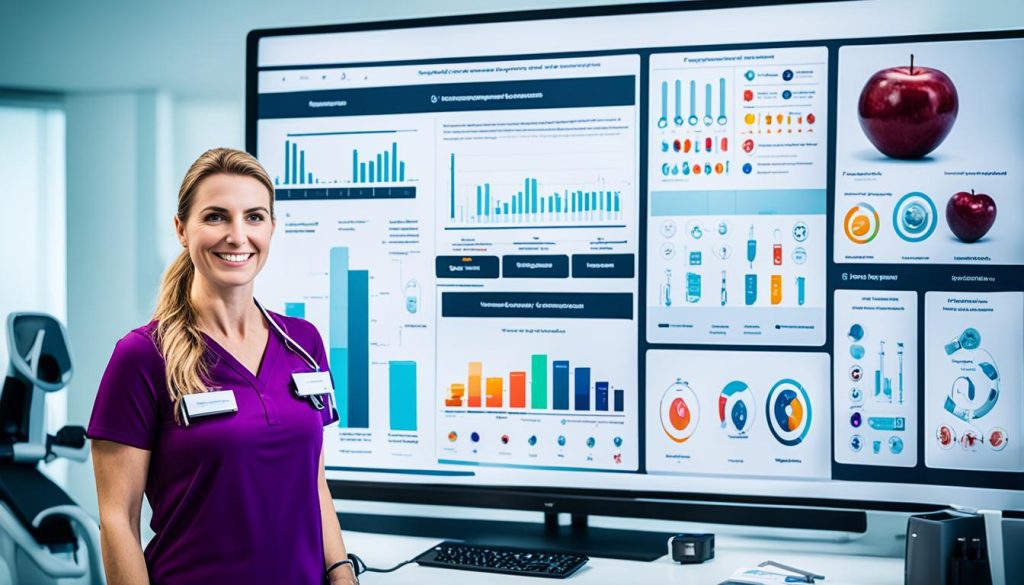Imagine spending a decade loving someone with a chronic illness. That’s been my reality. My wife has been battling endometriosis and fibromyalgia, conditions that have shaped not only her life but also mine. Witnessing her journey has sparked a deep understanding of the challenges faced by individuals with chronic illnesses and the importance of leveraging technology for health management and comfort.
Through our experience, I have come to realize the power of health technology solutions, such as smart healthcare devices and digital health tools, in providing personalized care and support. These innovative technologies have allowed us to monitor my wife’s symptoms, track her progress, and make well-informed decisions about her treatment. They have become our lifeline, offering convenience, empowerment, and peace of mind in our daily lives.
As I became more actively involved in advocating for my wife’s health, I discovered the therapeutic benefits of blogging. It became an outlet for me to share our journey, raise awareness about her conditions, and connect with others going through similar experiences. Blogging not only allowed me to escape the new normal of living with chronic illness but also provided a platform to educate and inspire others.
Not only has blogging been emotionally cathartic for me, but it has also had a profound impact on our financial future. Through my blog, I have been able to generate income and secure our financial stability by partnering with brands and companies that align with our mission. This additional income has relieved some of the burdens associated with chronic illness, providing us with a sense of security and allowing us to focus on my wife’s health and well-being.
In this blog series, I will delve into the world of digital health tools, exploring the latest advancements in health technology and sharing personal stories and insights gained from our journey. Together, we will discover how leveraging technology can enhance health management, provide comfort, and improve the overall well-being of individuals living with chronic illnesses.
Telemedicine and Virtual Appointments for Personalized Care
Telemedicine has revolutionized healthcare services, offering convenient and personalized care through remote consultations and virtual visits. With telemedicine, you can connect with your healthcare provider from the comfort of your home, eliminating the need for travel and saving valuable time. This is particularly beneficial for individuals with mobility issues or those residing in underserved areas.
Through telemedicine, you can have real-time communication with your healthcare provider during virtual appointments. This allows you to discuss your symptoms, medical history, and concerns, fostering an open and honest dialogue. Healthcare professionals can provide tailored advice and treatment recommendations, ensuring personalized care that suits your individual needs.
Telemedicine also enhances continuity of care, especially for patients with chronic conditions who require ongoing monitoring and management. Regular virtual visits enable healthcare providers to closely follow your progress, adjust treatment plans, and address any emerging health issues promptly.
Embracing telemedicine and virtual appointments empowers you to take control of your health while receiving personalized care from the convenience of your own home. It offers a flexible and accessible healthcare option to meet your unique needs.
Benefits of Telemedicine and Virtual Appointments:
- Convenient access to healthcare from anywhere
- Saves time and eliminates the need for travel
- Enables personalized care and tailored treatment recommendations
- Fosters open and honest communication with healthcare providers
- Enhances continuity of care, especially for chronic conditions
By embracing telemedicine and virtual appointments, you can experience the benefits of personalized care, remote consultations, and virtual visits, all while prioritizing your health and well-being.
Chatbots and Virtual Assistants for Patient Engagement
AI-powered chatbots and virtual assistants have revolutionized patient engagement in the healthcare industry. These digital tools provide automated interactions and personalized health advice, enhancing the overall patient experience. By leveraging pre-programmed algorithms and patient data, chatbots and virtual assistants offer immediate responses to patient inquiries, ensuring timely access to healthcare information and support.
Chatbots play a critical role in patient empowerment and self-care. They assist patients in understanding their symptoms and provide personalized recommendations for self-care actions. Whether it’s managing a common cold or monitoring chronic conditions, chatbots guide patients through appropriate steps and offer valuable insights to help them make informed decisions about their health.
Virtual assistants go beyond symptom management and provide comprehensive health advice. These intelligent tools leverage advanced algorithms to analyze patient data and offer tailored recommendations based on individual needs and conditions. Whether it’s providing guidance on medication management or offering lifestyle modifications for optimal health, virtual assistants act as personalized health coaches, supporting patients on their wellness journey.
Another significant benefit of chatbots and virtual assistants is that they save time for healthcare providers, enabling them to prioritize more complex cases. By automating routine interactions and providing immediate responses, these tools streamline communication and ensure that patients receive prompt attention. This enables healthcare professionals to dedicate more time and attention to patients with critical needs, resulting in a higher level of personalized care.
Below is a table summarizing the key features and benefits of chatbots and virtual assistants in patient engagement:
| Features | Benefits |
|---|---|
| Immediate Responses | Ensures timely access to healthcare information |
| Personalized Health Advice | Offers tailored recommendations based on individual needs and conditions |
| Self-Care Guidance | Empowers patients to manage their symptoms and take appropriate actions |
| Time Savings for Healthcare Providers | Enables healthcare professionals to prioritize complex cases |

By harnessing the power of chatbots and virtual assistants, healthcare organizations can optimize patient engagement and improve health outcomes. These digital tools enhance accessibility, provide personalized guidance, and empower patients to actively participate in their healthcare journey. As technology continues to advance, the role of chatbots and virtual assistants in patient engagement will only continue to grow, revolutionizing the way we interact with healthcare systems.
Data Analytics for Improved Health Outcomes
Data analytics is revolutionizing healthcare organizations’ ability to manage and optimize health outcomes. By analyzing large datasets from electronic health records, insurance claims, and other sources, healthcare providers can gain valuable insights into trends, risk factors, and prevalent health issues. This data-driven approach allows for targeted interventions and personalized support to improve patient outcomes and reduce unnecessary healthcare costs.
One of the key benefits of data analytics is its ability to identify patterns of non-adherence to treatment plans. By analyzing patient data, healthcare providers can gain a deeper understanding of why some patients may not be following their prescribed treatment plans. This insight enables them to provide personalized support and reminders to help patients stay on track, resulting in better health outcomes.
Furthermore, leveraging technology and data analytics enables healthcare providers to deliver more comprehensive and personalized care. By using advanced algorithms and predictive modeling, healthcare organizations can identify individuals at high risk for certain conditions and proactively intervene to prevent or manage those conditions. This proactive approach not only improves patient engagement and satisfaction but also leads to overall better health outcomes.
Example: Use of Data Analytics in Diabetes Management
A real-world example of data analytics’ impact on health outcomes is the management of diabetes. By analyzing data from electronic health records and blood glucose monitoring devices, healthcare providers can identify patterns and trends in blood sugar levels. This information allows for personalized treatment plans and medication adjustments, resulting in improved glycemic control and reduced risk of complications.
Here is an example table showcasing the impact of data analytics on diabetes management:
| Patient | Baseline A1C (%) | Post-intervention A1C (%) | Change in A1C (%) |
|---|---|---|---|
| Patient A | 8.5 | 7.2 | -1.3 |
| Patient B | 9.2 | 6.8 | -2.4 |
| Patient C | 7.8 | 7.0 | -0.8 |
This table demonstrates how data analytics can assist healthcare providers in tailoring treatment plans and interventions to effectively manage patients’ diabetes. The analysis of patients’ A1C levels before and after the intervention showcases the positive impact of personalized care on improving glycemic control and reducing the risk of diabetes-related complications.
By harnessing the power of data analytics, healthcare organizations can make informed decisions, deliver personalized care, and ultimately improve health outcomes for patients. This technology-driven approach enables healthcare providers to optimize their resources and interventions, leading to more effective and patient-centered healthcare delivery.
Closing the Digital Divide for Equitable Access to Technology
Access to digital technology is crucial for leveraging its benefits in healthcare. Closing the digital divide is essential to ensure equitable access to technology and its applications. Major investments are needed to increase connectivity and digital literacy, especially among the poorest and most vulnerable populations. Individuals and communities cannot benefit from digital technologies if they lack access. Efforts should focus on providing equal opportunities for all to access, utilize, and benefit from technology-based health management solutions.
Improving digital access and literacy is a key step towards achieving equitable healthcare. By bridging the digital divide, underserved communities can gain access to tools and resources that can significantly improve their health outcomes. It is essential to invest in infrastructure, such as high-speed internet connectivity and affordable devices, in remote and marginalized areas.
To address the issue of digital literacy, educational initiatives should be implemented to empower individuals with the necessary skills to effectively navigate technology. Training programs, workshops, and community outreach can play a vital role in promoting digital literacy and empowering individuals to take control of their health using digital tools.
Benefits of Closing the Digital Divide
Closing the digital divide can have numerous benefits for healthcare and society as a whole. Here are some key advantages:
- Improved access to healthcare: Equitable access to technology ensures that individuals can connect with healthcare providers, access health information, and avail telemedicine services regardless of their geographical location.
- Enhanced health outcomes: Closing the digital divide allows individuals to actively engage in their health management, leading to improved adherence to treatment plans, better chronic disease management, and reduced healthcare disparities.
- Empowerment of marginalized communities: Providing equitable access to technology enables marginalized communities to have a voice in their healthcare decisions, gain health knowledge, and actively participate in their well-being.
- Promotion of digital inclusion: Closing the digital divide fosters inclusivity and ensures that technology-based health solutions are accessible to all, regardless of socioeconomic status, race, or ethnicity.
Investing in closing the digital divide is an investment in the future of healthcare. By ensuring equitable access to technology and promoting digital literacy, we can create a more inclusive healthcare system that leverages the power of technology to improve health outcomes for all.

People-Centered Design for Effective Technological Solutions
When it comes to technological solutions for health, one size does not fit all. It is crucial to design these solutions with the end-users in mind. By involving users in the design and development process, we can ensure that digital approaches are user-friendly and address real-world health needs. This approach is known as people-centered design or human-centered design.
People-centered design emphasizes the importance of understanding and considering users’ perspectives, preferences, and experiences. By putting the needs of end-users at the forefront, we can create technological solutions that truly meet their expectations and requirements. This approach is especially important when designing technology-based health solutions, as it directly impacts the usability and effectiveness of these tools.
By adopting a people-centered approach, we can enhance the impact of technological solutions for health. User-friendly designs lead to better engagement and acceptance among end-users, resulting in improved health outcomes. When end-users feel that their needs and preferences are valued, they are more likely to embrace and adhere to the technology-based interventions.
To illustrate the importance of people-centered design, let’s take the example of a health monitoring app. By involving end-users in the design process, we can gather insights into their specific health concerns and desired features. This input can help us create an intuitive and customized app interface that meets their needs. Additionally, feedback from end-users can guide the continual improvement of the app, ensuring that it remains relevant and user-friendly.
By considering the end-users’ perspectives and involving them in the design and development process, we can create technological solutions that truly make a difference in healthcare. People-centered design is a key element in ensuring the success and effectiveness of technological interventions for health.
Benefits of People-Centered Design:
- Improved usability and user-friendliness
- Enhanced engagement and acceptance
- Higher levels of satisfaction among end-users
- Better adherence to technology-based interventions
- Positive impact on health outcomes
People-Centered Design Process
| Step | Description |
|---|---|
| 1 | Identify end-users and stakeholders |
| 2 | Understand the needs and preferences of end-users |
| 3 | Collaborate with end-users in the design process |
| 4 | Prototype and test the solution with end-users |
| 5 | Incorporate feedback and iterate on the design |
| 6 | Continuously evaluate and improve the solution |
Tailoring Digital Solutions for Specific Settings and Populations
When it comes to digital technologies in healthcare, there is no one-size-fits-all solution. Every national health system and population have unique needs and relationships with technology and health data. To maximize the impact of digital solutions, it is crucial to tailor them to specific settings and populations.
Understanding the diverse health challenges between and within countries is essential. By taking into account the specific needs and contexts of different populations, healthcare systems can develop digital solutions that address their unique health concerns. This involves involving the end-users in the design and implementation process to ensure the solutions meet their requirements and preferences.
For example, in developing countries with limited access to healthcare facilities, mobile health applications can be designed to provide remote consultations and access to medical information. In urban settings, where access to healthcare might not be a significant issue, digital solutions can focus on improving health education and preventive care.
By tailoring digital solutions to specific settings and populations, healthcare systems can promote health equity and optimize the effectiveness of technology in improving health outcomes. Let’s take a look at some examples:
Examples of Tailored Digital Solutions
- Interactive educational tools: These tools can be designed to address the specific health concerns and risks prevalent in different regions or populations. For example, a tool aimed at educating pregnant women in rural areas may focus on nutrition, prenatal care, and childbirth practices relevant to their specific cultural context.
- Language and cultural adaptation: Digital solutions should be available in multiple languages and culturally sensitive to ensure accessibility and relevance to diverse populations. For instance, a mental health app developed for a multicultural society may offer content and resources in different languages and include culturally appropriate interventions.
- Accessibility features: Digital solutions should be designed with accessibility in mind to cater to individuals with disabilities and impairments. These features can include text-to-speech functionality, high contrast visuals, and alternative input methods to accommodate the needs of diverse users.
By prioritizing user-driven digital transformation and tailoring solutions to specific settings and populations, we can ensure that technology effectively addresses the unique health needs of individuals and communities. Let’s take a closer look at how different healthcare systems have successfully tailored digital solutions in the table below:

As the table above illustrates, healthcare systems around the world have successfully tailored digital solutions to address specific health challenges and improve outcomes for diverse populations. By understanding the specific needs of different settings and populations, we can ensure that digital technologies are best utilized to enhance healthcare delivery and overall wellness.
Ensuring Equity and Protecting Human Rights in Digital Health
Digital technologies have the potential to exacerbate health inequalities if not implemented thoughtfully. Ensuring equity and protecting human rights in digital health is crucial. All populations, regardless of wealth, gender, age, education, social status, or stigma, deserve equal access to digital tools and health data.
Digital technologies should be grounded in privacy, confidentiality, social inclusion, and respect for human rights. Efforts should be focused on reducing health disparities and promoting equitable access to technology-based health management solutions. By prioritizing equity and human rights, we can harness the power of digital technologies to improve health outcomes for all individuals and communities.
Examples of Ensuring Equity and Protecting Human Rights in Digital Health:
- Implementing strict data protection measures to safeguard personal health information
- Ensuring access to digital health resources for underserved communities
- Addressing the gender divide in technology access and usage
- Providing digital literacy and skills training to bridge the digital divide
- Promoting cultural sensitivity and inclusivity in the design of digital health solutions
By embracing these principles, we can create a more equitable and inclusive digital health ecosystem, where everyone has equal opportunities to benefit from technological advancements in healthcare.
| Challenges | Solutions |
|---|---|
| Unequal access to digital tools and resources | Investing in infrastructure and connectivity to bridge the digital divide |
| Lack of digital literacy and skills | Providing digital education and training programs |
| Discrimination and stigma in healthcare | Integrating diversity and inclusion principles in digital health design and implementation |
| Privacy and data security concerns | Implementing robust data protection measures and privacy regulations |
Building and Sustaining Public Sector Infrastructure and Capacity
Strengthening the digital capacity of the public sector is essential for maximizing the benefits of digital technologies in health. Limited digital capacity in the public sector is a barrier to the effective implementation of digital tools and can hinder healthcare access and outcomes.
Efforts should focus on building and sustaining public sector infrastructure and capacity to effectively utilize digital tools and improve health access and outcomes. This requires investments in training, technology infrastructure, and support systems at the local, regional, and national levels.
By prioritizing the development of robust public sector infrastructure, governments can lay the foundation for enhanced healthcare services. Investing in training programs and capacity building initiatives equips healthcare professionals with the necessary skills to leverage digital tools effectively. Additionally, establishing reliable technology infrastructure and support systems ensures a seamless integration of digital technologies into healthcare workflows.

The development and maintenance of public sector infrastructure also contribute to improved health access and outcomes. By embracing digital tools, healthcare providers can enhance communication, information sharing, and collaboration across different levels of the healthcare system.
Furthermore, robust public sector infrastructure enables the efficient collection, integration, and analysis of health data. This data-driven approach facilitates evidence-based decision-making, enabling healthcare providers to identify health trends, allocate resources effectively, and optimize health services delivery.
Investing in building and sustaining public sector infrastructure and capacity is crucial to ensure that digital technologies can truly revolutionize healthcare delivery. By doing so, governments can create an enabling environment that allows for the seamless integration and utilization of digital tools, ultimately enhancing health access and outcomes for communities.
Leveraging Digital Transformation for Health Equity
The promise of digital transformation in healthcare is immense when it comes to promoting health equity. To fully realize this potential, it requires inclusive, strategic, and well-resourced efforts. By adopting a comprehensive approach and leveraging technology effectively, we can address the disparities in healthcare access and outcomes that currently exist. Let’s explore the key strategies and actions that can help us achieve health equity through digital transformation.
Addressing the Digital Divide
To ensure health equity, it is crucial to bridge the digital divide that exists in our society. This divide refers to the disparities in access to digital technology and internet connectivity. By investing in infrastructure and initiatives to increase connectivity and digital literacy, we can empower underserved communities and marginalized populations to access the benefits of digital health solutions.
Embracing People-Centered Design
People-centered design is vital in developing digital health solutions that cater to the diverse needs of individuals and communities. By involving end-users in the design process, we can create user-friendly and culturally appropriate solutions that address specific healthcare challenges. Prioritizing user perspectives and preferences ensures that digital transformation is truly inclusive and responsive to the needs of all.
Tailoring Solutions to Specific Contexts
Healthcare needs and contexts vary across different settings and populations. To achieve health equity, it is essential to tailor digital solutions to these specific contexts. By understanding the unique challenges and requirements of different communities, we can develop targeted approaches that effectively address their health concerns and improve outcomes.
Protecting Human Rights
As we leverage digital transformation, it is paramount to protect human rights, privacy, and confidentiality. Respecting the rights of individuals, including their autonomy and dignity, should be at the forefront of any digital health initiative. By upholding ethical standards and ensuring data security, we can build trust and foster equitable access to digital health technologies.
Building Public Sector Infrastructure and Capacity
The public sector plays a critical role in ensuring equitable access to digital health technologies. By investing in the necessary infrastructure and building capacity within the public healthcare system, we can facilitate the effective implementation of digital tools and interventions. This requires training healthcare professionals, improving technology infrastructure, and establishing support systems at all levels of the healthcare system.
| Benefits of Leveraging Digital Transformation for Health Equity |
|---|
| 1. Increased accessibility to healthcare services for underserved populations |
| 2. Improved patient engagement and empowerment through personalized care |
| 3. Enhanced data analytics for targeted interventions and improved health outcomes |
| 4. Reduction in healthcare disparities and improved overall population health |
| 5. Efficient and cost-effective healthcare delivery |
Leveraging digital transformation in strategic ways is crucial for achieving health equity. By addressing the digital divide, adopting people-centered design, tailoring solutions to specific contexts, protecting human rights, and building public sector infrastructure and capacity, we can ensure that technology-driven healthcare advancements benefit all individuals and communities, regardless of their background or circumstances. Together, let’s embrace digital transformation as a catalyst for health equity.
The Role of Digital Technology in Global Health
Digital technology has become an indispensable tool in advancing global health, bringing significant improvements to health systems and outcomes on a worldwide scale.
Through digital tools, individuals now have increased access to vital health information, easier linkage to health services, and opportunities for disease surveillance and self-management of chronic conditions. These advancements have shown remarkable benefits in improving health outcomes and empowering individuals to take charge of their own well-being.
However, it is essential to acknowledge that efforts to leverage digital technology in health have been partial, fragmented, and underfunded. As a result, there is still work to be done to ensure the full potential of digital technology is harnessed in promoting global health.
Closing the digital divide is a fundamental step toward achieving equitable access to digital health solutions. Empowering end-users, regardless of their geographical location or socio-economic status, is vital to creating a truly inclusive and effective digital health ecosystem.
Furthermore, ensuring equity and protecting human rights are paramount in utilizing digital technology for global health. All individuals, regardless of their background, deserve equal access to digital tools and health data. It is crucial to prioritize privacy, confidentiality, social inclusion, and respect for human rights when implementing digital health initiatives.
The Impact of Digital Technology
Let’s take a closer look at how digital technology has transformed different aspects of global health:
| Aspect of Global Health | Impact of Digital Technology |
|---|---|
| Access to Health Information | Provides individuals with accurate and up-to-date health information, empowering them to make informed decisions about their health. |
| Linkage to Health Services | Enables individuals to connect with healthcare providers remotely, reducing barriers such as distance and transportation. |
| Disease Surveillance | Aids in early detection and tracking of infectious diseases, allowing for timely interventions and prevention strategies. |
| Chronic Disease Management | Facilitates self-management of chronic conditions through apps and wearable devices, empowering individuals to monitor their health and adhere to treatment plans. |
By leveraging digital technology in global health, we can bridge gaps in access, improve health systems, and ultimately enhance health outcomes for individuals and communities worldwide.
Conclusion: Leveraging Technology for Health Management and Comfort
In today’s rapidly evolving healthcare landscape, leveraging technology for health management and comfort has become increasingly important. With the advent of telemedicine, virtual appointments, chatbots, and data analytics, healthcare providers can now offer personalized care and enhance patient engagement. These healthcare innovations and technological interventions for wellness have the potential to greatly improve health outcomes and transform the delivery of care.
By adopting telemedicine and virtual appointments, individuals can now connect with healthcare providers from the comfort of their own homes, reducing travel time and waiting periods. Real-time communication and open dialogue between patients and healthcare professionals foster personalized care tailored to individual needs. Additionally, AI-powered chatbots and virtual assistants provide immediate responses and personalized health advice, revolutionizing patient engagement and support.
Data analytics plays a significant role in health management and comfort by identifying trends, risk factors, and prevalent health issues. This enables healthcare providers to intervene with targeted interventions and personalized support. Furthermore, efforts to close the digital divide, prioritize people-centered design, and ensure equity and human rights are vital to providing access to technology-based health solutions for all individuals. Only by leveraging technology in strategic and inclusive ways can we truly transform healthcare and enhance the wellness journey for individuals with chronic illnesses.
